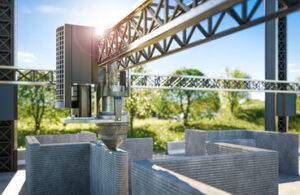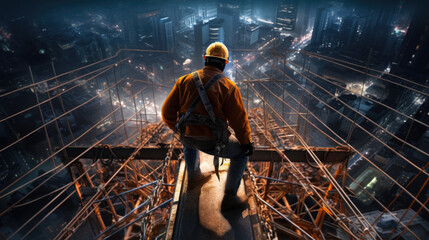Concrete is the foundation of the tallest buildings and infrastructure that last for centuries. Innovative technologies are enhancing this material in new and unexpected ways.
These trends in concrete construction technology will lower construction costs, improve efficiency, and empower workers. From bendable concrete to self-healing concrete, these innovations will transform the industry. Visit https://concretecontractorcoloradosprings.com/ for more information about these innovations.
 Translucent Concrete
Translucent Concrete
Concrete, that traditionally a solid building material, is getting a makeover designed to let the light shine in. Engineers have developed concrete mixtures that can transmit light by switching out traditional ingredients for transparent ones or embedding fiber optics.
The former is a polymer-based process that can turn ordinary concrete into translucent blocks that can be used as walls or other structural elements. Glass pieces are mixed into the mix or plastic rebar is substituted for steel to give the new concrete its see-through properties. The latter uses concrete that has been reinforced with plastic strands that can be cut to shape, giving architects the flexibility to customize the concrete’s translucency.
A company is currently working on a product they call “light transmitting concrete.” The LTC block is infused with optical fibers that allow light to shine through it. The light can be dimmed or brightened using simple electrical systems.
The product’s main benefits are related to green technology and aesthetics. The use of natural light in buildings reduces electricity consumption and helps to create a healthy environment with better interior illumination. Moreover, it also increases the efficiency of thermal insulation and improves energy efficiency with internal heat systems.
Despite these benefits, there are several challenges that the transparent concrete industry must overcome to become a viable alternative to normal concrete. One of the main problems is the cost of infusing concrete with optical fibers. It is a costly process and there are not enough expert individuals available to handle the task. However, researchers are constantly seeking ways to lower the production costs of the material and make it more affordable for construction companies.
Bio Concrete
Concrete construction is notoriously hard on buildings, especially in areas with harsh winters that cause a lot of freeze-thaw cycles. These cycles can lead to cracking that eventually leads to the breakdown of the structure, which is expensive and time-consuming to repair. Researchers have been looking for ways to extend the lifespan of concrete. One innovative solution is a new type of self-healing concrete that uses bacteria.
In this innovation, microencapsulation is used to protect the bacteria inside the concrete matrix. The bacteria can then grow and survive, even when the concrete is under stress. This can increase the overall strength and durability of the concrete. It also reduces the maintenance costs of the concrete over its lifetime.
A researcher developed this new concrete material. He embedded limestone-producing bacteria in the concrete that activate when they detect cracks. These bacteria produce calcium carbonate, which helps to fill the cracks in the concrete and prevent them from expanding.
The research has shown that bacterial concrete can be used in bridges, roads, and other structures that need to be strong and durable. It can save on repair and maintenance costs that can run into the billions for cities, building owners, and homeowners.
There are still several hurdles to overcome to implement this technology in the real world. Firstly, it must be tested under various conditions to validate the performance of the concrete. Non-destructive testing methods can be used, such as acoustic emission tests, to evaluate the concrete’s integrity. Secondly, it must be proved that the bacteria can survive in the concrete for long periods and still function as intended.
Chronos Chromos Concrete
A trio of designers has developed a way to incorporate dynamic patterns, words, numbers, and information displays into concrete. The innovative material uses thermochromatic pigment and nickel-chromium wires that heat up when an electric current passes through them to cause the concrete just above or below it to change color. By using a microprocessor control system to manipulate the color-changing pattern, it’s possible to display graphics, dot-matrix clocks, and other forms of information in concrete.
While some scientists work to lighten concrete for more streamlined architectural forms, others dream of making it semi-transparent. Some have even succeeded, with one example being the translucent concrete which combines optical fibers and BASF’s polymers to allow light to pass through blocks 20 cm thick.
More realistically, researchers have developed ultra-high-performance fiber-reinforced concrete, or UHPFRC, which has six to eight times the mechanical strength of standard concrete and is up to 40% lighter. It’s also more resistant to cracking, a benefit for structures in seismic zones, and can be manufactured in a fraction of the time that it takes to make traditional concrete.
The aforementioned innovations are just the tip of the iceberg when it comes to new concrete construction technologies. An accredited professional and “40 Under 40” winner tracks the newest building products from around the world and writes about them in his weekly online newsletter and his two books. You can find him on his website. He’s a frequent contributor to the magazine.
Engineered Cement Composites
Another innovation in concrete construction technology can offer improved mechanical properties like tensile strength and ductility. Unlike conventional concrete, it exhibits multiple cracking and strain hardening, which is beneficial in improving the durability of infrastructure projects. It also has a low embodied energy, which makes it an ideal material for sustainable buildings.
it is a combination of cement, mineral admixtures, fine aggregates, water, superplasticizers, and up to 2% fibers. The use of mineral admixtures such as fly ash, silica fume, slag, and recycled powder increases impermeability, reduces costs, and lowers carbon emissions. It can be molded into complex shapes and used in projects with tight schedules.
Researchers are developing new methods to improve the performance of this material by recycling wastes and incorporating different fillers. One example is calcined clay cement (LC3), which replaces 50% of the OPC to achieve a similar hydration and clinker content. This material also produces a higher level of carbonate aluminates, which enhances the bonding between the fibers and matrix.
Other innovations include the introduction of high-strength fibers such as polyvinyl alcohol fiber (PVA fiber), polypropylene fiber (PP fiber), carbon fiber (CF fiber), and basalt fiber to increase the tensile strength and stiffness of the material. However, if the fibers are not properly blended into the concrete, they can weaken the interface performance between the fiber and the matrix.
Another development is self-compacting concrete. This is a type that can flow under its weight without the need for vibration or shaking to ensure even distribution. It can be used for construction work that requires a quick turnaround, such as tunnel or sewer linings. Self-compacting concrete is made possible by the use of chemical admixtures that decrease the viscosity of the material and control particle interactions with mixed proportioning.
Drones
Concrete is the material of choice for many of the world’s tallest buildings and infrastructure designed to last centuries. To meet these demands, innovations in concrete construction technology are enhancing the strength, durability, and workability of this ancient building material. From bendable concrete to smog-eating concrete, these new technologies are enhancing a construction staple nearly 5,000 years in the making.
Concrete contractors are embracing new trends to make their jobs more efficient and safe on-site. From robots that can help with rebar tying and demolition to high-tech atomized dust suppression solutions, these technologies are making it easier for contractors to keep projects moving even in the face of quarantines or pandemic threats.
A popular new concrete construction innovation is 3D printing, which has the potential to change the way that structures are built. This innovative technology eliminates the need for traditional formwork, reducing the amount of time that is required to construct a structure and ultimately saving both money and resources.
Another emerging concrete technology is geopolymer concrete, which is an alternative to cement. It is made by using fly ash or slag in combination with chemical activators to create a polymer that replaces the traditional binder in concrete. The result is concrete that has an expected lifespan of more than 75 years, compared to traditional concrete’s 15-25 years.
Aside from being more environmentally friendly, this new concrete can also be self-healing. In this case, the concrete is enhanced with titanium dioxide, which eats smog and toxins, helping to clean the air as it ages. According to an article, this “smart concrete” may soon be used on Interstate highways to tell engineers when the concrete needs repair or is nearing its maximum strength.

